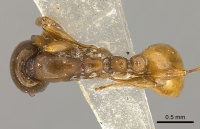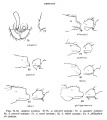Aenictus powersi
| Aenictus powersi | |
|---|---|

| |
| Scientific classification | |
| Kingdom: | Animalia |
| Phylum: | Arthropoda |
| Class: | Insecta |
| Order: | Hymenoptera |
| Family: | Formicidae |
| Subfamily: | Dorylinae |
| Genus: | Aenictus |
| Species: | A. powersi |
| Binomial name | |
| Aenictus powersi Wheeler, W.M. & Chapman, 1930 | |
The type series was collected from beneath a piece of wood in a garden.
Identification
A member of the pachycerus group.
Keys including this Species
Distribution
Latitudinal Distribution Pattern
Latitudinal Range: 9.3023° to 9.3023°.
| North Temperate |
North Subtropical |
Tropical | South Subtropical |
South Temperate |
- Source: AntMaps
Distribution based on Regional Taxon Lists
Indo-Australian Region: Philippines (type locality).
Distribution based on AntMaps
Distribution based on AntWeb specimens
Check data from AntWeb
Countries Occupied
| Number of countries occupied by this species based on AntWiki Regional Taxon Lists. In general, fewer countries occupied indicates a narrower range, while more countries indicates a more widespread species. |

|
Estimated Abundance
| Relative abundance based on number of AntMaps records per species (this species within the purple bar). Fewer records (to the left) indicates a less abundant/encountered species while more records (to the right) indicates more abundant/encountered species. |

|
Biology
Castes
Known only from the worker caste.
   
| |
| . | Owned by Museum of Comparative Zoology. |
Nomenclature
The following information is derived from Barry Bolton's Online Catalogue of the Ants of the World.
- powersi. Aenictus (Aenictus) powersi Wheeler, W.M. & Chapman, in Wheeler, W.M. 1930g: 210, fig. 6e-h (w.) PHILIPPINES (Negros).
- Type-material: syntype workers (number not stated, “several”).
- Type-locality: Philippines: Negros, Dumaguete, 1800 ft (J.W. Chapman).
- Type-depository: MCZC.
- Status as species: Chapman & Capco, 1951: 12; Chapman, 1963: 262; Wilson, 1964a: 475; Baltazar, 1966: 231; Bolton, 1995b: 60; Jaitrong & Wiwatwitaya, 2013: 98 (in key).
- Distribution: Philippines (Negros).
Unless otherwise noted the text for the remainder of this section is reported from the publication that includes the original description.
Description
Worker
WORKER. Length 2.5-3 mm.
Head scarcely longer than broad, subrectangular, nearly as broad behind as in front, with feebly rounded sides and straight posterior border, the posterior corners rounded, not produced. Frontal and genal carinae very short, the latter not dentate. Clypeus concave, with narrow, translucent anterior border, sub triangular, with a large blunt apical tooth and several minute, irregular basal dentides on the terminal border, the external border convex. Antennae short, the scapes thickened apically, reaching to the posterior third of the head, first funicular joint small, as long as broad, joints 2-8 slightly broader than long, terminal joint a little longer than the two penultimate joints together. Pronotum slightly flattened above, the mesonotum short, sloping to the mesoepinotal constriction, which is moderately pronounced. Epinotum with convex base and concave declivity, the boundary between the two developed as a blunt point. Petiole nearly as broad as long, its node evenly rounded and hemispherical, the ventral surface with a transparent lamina, produced behind as a downwardly and backwardly directed spine. Postpetiolar node resembling the petiolar node but somewhat broader and slightly broader than long, anteroventrally with a well developed tool;h, which is directed downward and forward. Gaster regularly elliptical. Legs with incrassated femora and tibae.
Mandibles opaque, finely and densely shagreened. Remainder of body smooth and shining, with fine, sparse, piligerous punctures, except the mesopleurae, mesoepinotal constriction, sides of epinotum and ventral surfaces of the petiole and postpetiole, which are sub opaque, finely and densely punctate.
Hairs white, uneven, rather delicate, sparse on the body, short on the appendages.
Mandibles, antennal fovere and anterior border of head reddish brown, remainder of head, antennal scapes and thorax yellowish red; pedicel, gaster and legs, including the coxre, yellow; antennal funiculi brown, except the terminal joint, which is yellowish red like the scapes.
Wilson (1964) - Syntypes: Worker selected at random: HW 0.78 mm, HL 0.74 mm, SL 0.45 mm. HW of 29 other syntypes 0.68-0.80mm. Antenna 10-segmented. Mandible typical in form; in closure leaving a small gap between its posterior border and anterior clypeal border. Clypeus convex, entire, unarmed. Parafrontal ridge weakly defined, only 0.12 mm long. Occiput straight, lacking collar. Basal face of propodeum straight. Propodeal junction smoothly rounded, with no trace of a ridge. Subpetiolar process very large, consisting of a subretangular lobe surmounted by a large, ventrally curving, acute flange. Pilosity sparse; only 10-25 hairs breaking the mesosomal profile. Length of longest pronotal hairs only about 0.25 mm.
Head shining, except for mandibles, which are microreticulate and opaque. Anterior face of pronotum, metanotum, mesopleuron, metapleuron, and sides of propodeum microreticulate and subopaque; remainder shining. Dorsum of pedicel shining; the rest microreticulate and opaque. Mostly clear medium yellow; parts of alitrunk with a brownish tinge.
Type Material
Described from several workers taken near Dumaguete at an altitude of 1,800 feet from a single colony under a piece of wood in a garden. This species is hypogaeic.
Type locality: Dumaguete, 540 m, Negros, P. I.
References
- Chapman, J. W.; Capco, S. R. 1951. Check list of the ants (Hymenoptera: Formicidae) of Asia. Monogr. Inst. Sci. Technol. Manila 1: 1-327 (page 12, checklist)
- Jaitrong, W. & Wiwatwitaya, D. 2013. Two new new species of the Aenictus pachycerus species group (Hymenoptera: Formicidae: Aenictinae) from Southeast Asia. Raffles Bulletin of Zoology 61, 97-102.
- Wheeler, W. M. 1930j. Philippine ants of the genus Aenictus with descriptions of the females of two species. J. N. Y. Entomol. Soc. 38: 193-212 (page 210, fig. 6 worker described)
- Wilson, E. O. 1964a. The true army ants of the Indo-Australian area (Hymenoptera: Formicidae: Dorylinae). Pac. Insects 6: 427-483 (page 475, see also)
References based on Global Ant Biodiversity Informatics
- Borowiec M. L. 2016. Generic revision of the ant subfamily Dorylinae (Hymenoptera, Formicidae). ZooKeys 608: 1–280.
- Chapman, J. W., and Capco, S. R. 1951. Check list of the ants (Hymenoptera: Formicidae) of Asia. Monogr. Inst. Sci. Technol. Manila 1: 1-327
- Chapman, J.W. and S.R. Capco. 1951. Check list of the ants (Hymenoptera: Formicidae) of Asia. Monographs of the Institute of Science and Technology (Manila) 1: 1- 327


